Literature Review: Smoking Cessation in Aboriginal Populations
VerifiedAdded on 2020/04/01
|7
|1670
|33
Literature Review
AI Summary
This literature review examines the effectiveness of various interventions aimed at smoking cessation and harm minimization within the Aboriginal Australian population. The review synthesizes findings from multiple databases, including CINAHL, MEDLINE, and the Cochrane Library, focusing on both qualitative and quantitative studies. Key findings highlight the impact of smoke-free policies, media campaigns, and increased tobacco taxes on reducing smoking rates. The review also explores the effectiveness of various intervention strategies, such as counseling, school-based programs, and community-based initiatives. The critical appraisal of studies evaluates the quality and effectiveness of each intervention, providing insights for future recommendations and the sustainability of these techniques. The study emphasizes the importance of culturally adapted approaches and the need for a multifaceted strategy to address smoking cessation among Aboriginal populations, considering factors like media influence, personal testimonials, and the role of community acceptance of tobacco consumption.

Running head: RESEARCH LITERACY FOR HEALTH PRACTICE
Literature review on smoking cessation and harm minimization among aboriginals
Name of the Student
Name of the University
Author Note
Literature review on smoking cessation and harm minimization among aboriginals
Name of the Student
Name of the University
Author Note
Paraphrase This Document
Need a fresh take? Get an instant paraphrase of this document with our AI Paraphraser
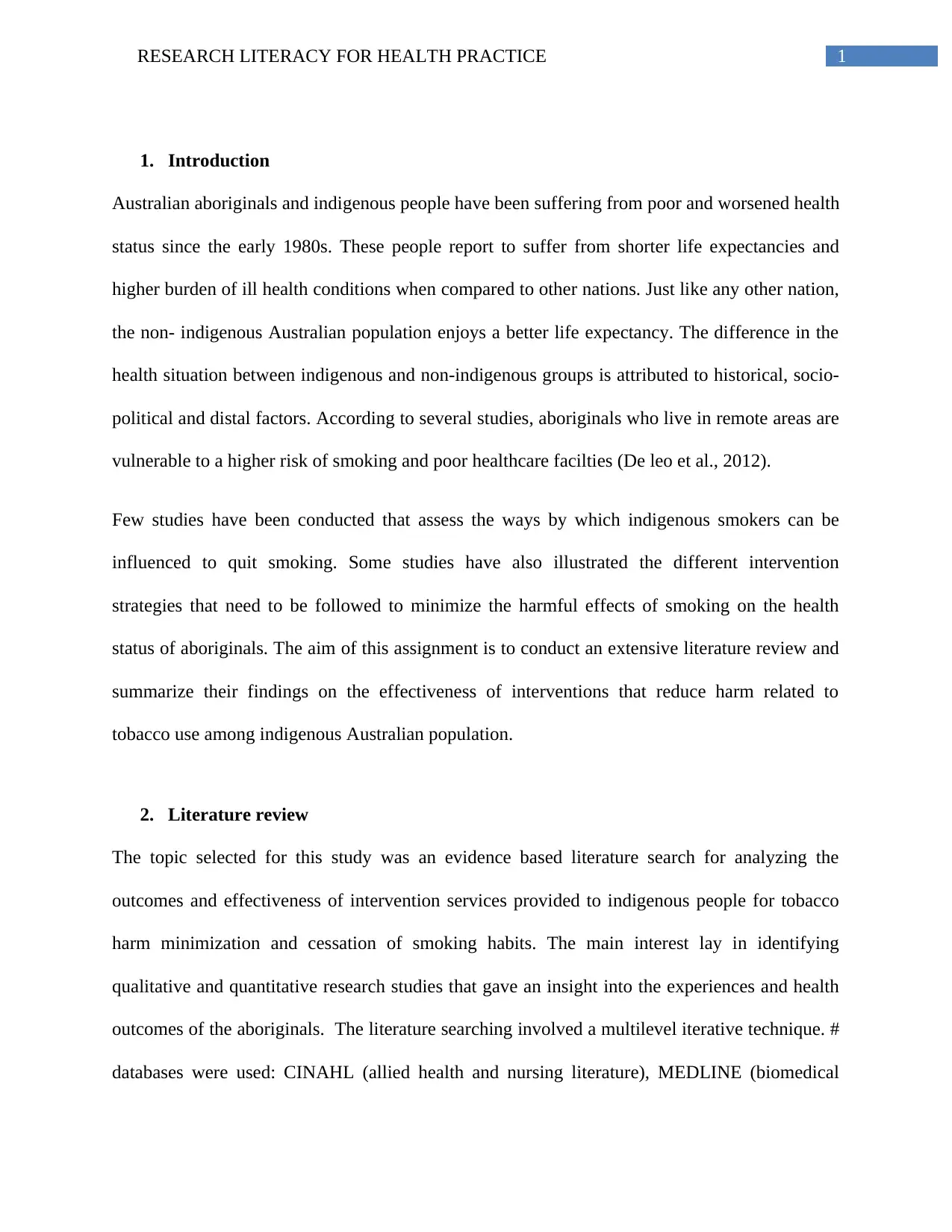
1RESEARCH LITERACY FOR HEALTH PRACTICE
1. Introduction
Australian aboriginals and indigenous people have been suffering from poor and worsened health
status since the early 1980s. These people report to suffer from shorter life expectancies and
higher burden of ill health conditions when compared to other nations. Just like any other nation,
the non- indigenous Australian population enjoys a better life expectancy. The difference in the
health situation between indigenous and non-indigenous groups is attributed to historical, socio-
political and distal factors. According to several studies, aboriginals who live in remote areas are
vulnerable to a higher risk of smoking and poor healthcare facilties (De leo et al., 2012).
Few studies have been conducted that assess the ways by which indigenous smokers can be
influenced to quit smoking. Some studies have also illustrated the different intervention
strategies that need to be followed to minimize the harmful effects of smoking on the health
status of aboriginals. The aim of this assignment is to conduct an extensive literature review and
summarize their findings on the effectiveness of interventions that reduce harm related to
tobacco use among indigenous Australian population.
2. Literature review
The topic selected for this study was an evidence based literature search for analyzing the
outcomes and effectiveness of intervention services provided to indigenous people for tobacco
harm minimization and cessation of smoking habits. The main interest lay in identifying
qualitative and quantitative research studies that gave an insight into the experiences and health
outcomes of the aboriginals. The literature searching involved a multilevel iterative technique. #
databases were used: CINAHL (allied health and nursing literature), MEDLINE (biomedical
1. Introduction
Australian aboriginals and indigenous people have been suffering from poor and worsened health
status since the early 1980s. These people report to suffer from shorter life expectancies and
higher burden of ill health conditions when compared to other nations. Just like any other nation,
the non- indigenous Australian population enjoys a better life expectancy. The difference in the
health situation between indigenous and non-indigenous groups is attributed to historical, socio-
political and distal factors. According to several studies, aboriginals who live in remote areas are
vulnerable to a higher risk of smoking and poor healthcare facilties (De leo et al., 2012).
Few studies have been conducted that assess the ways by which indigenous smokers can be
influenced to quit smoking. Some studies have also illustrated the different intervention
strategies that need to be followed to minimize the harmful effects of smoking on the health
status of aboriginals. The aim of this assignment is to conduct an extensive literature review and
summarize their findings on the effectiveness of interventions that reduce harm related to
tobacco use among indigenous Australian population.
2. Literature review
The topic selected for this study was an evidence based literature search for analyzing the
outcomes and effectiveness of intervention services provided to indigenous people for tobacco
harm minimization and cessation of smoking habits. The main interest lay in identifying
qualitative and quantitative research studies that gave an insight into the experiences and health
outcomes of the aboriginals. The literature searching involved a multilevel iterative technique. #
databases were used: CINAHL (allied health and nursing literature), MEDLINE (biomedical
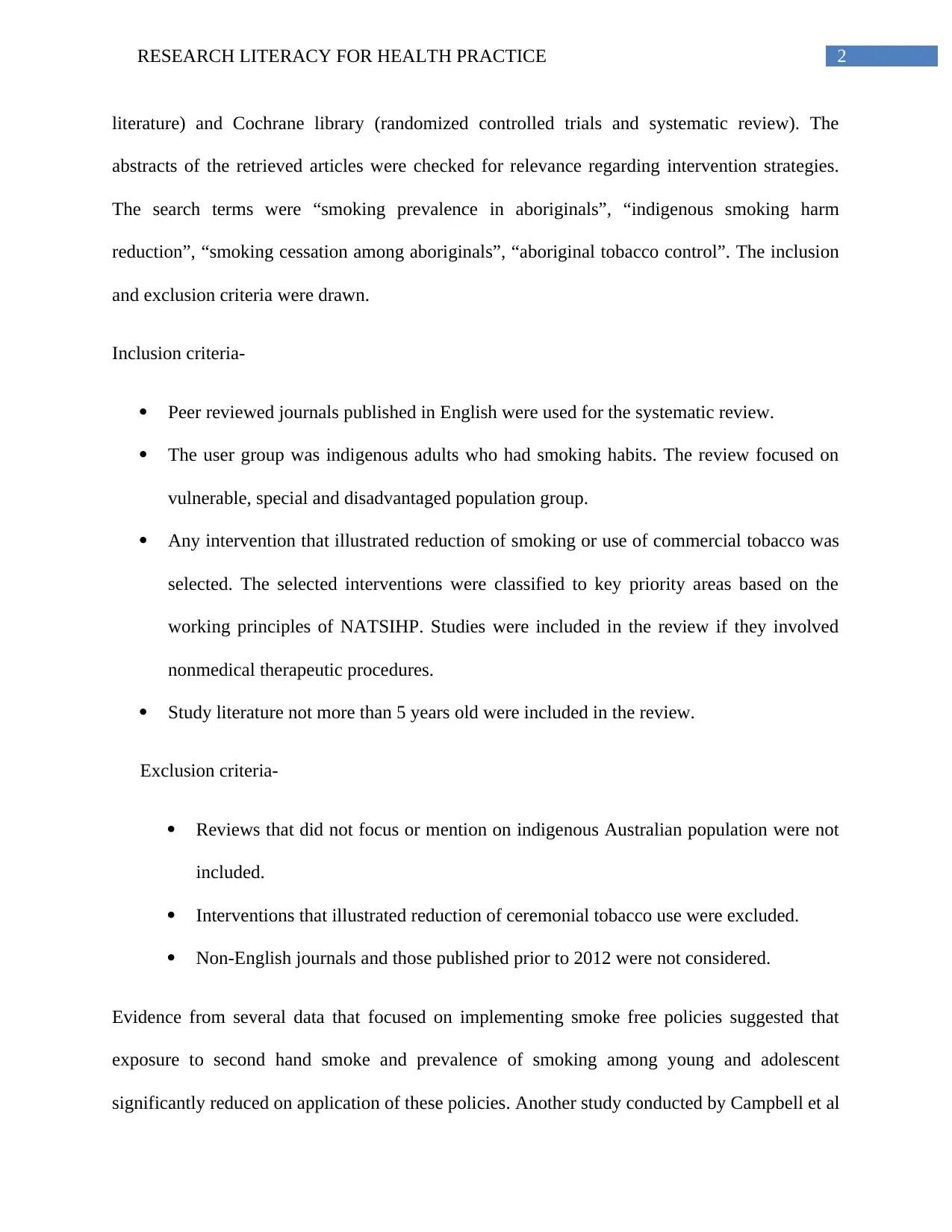
2RESEARCH LITERACY FOR HEALTH PRACTICE
literature) and Cochrane library (randomized controlled trials and systematic review). The
abstracts of the retrieved articles were checked for relevance regarding intervention strategies.
The search terms were “smoking prevalence in aboriginals”, “indigenous smoking harm
reduction”, “smoking cessation among aboriginals”, “aboriginal tobacco control”. The inclusion
and exclusion criteria were drawn.
Inclusion criteria-
Peer reviewed journals published in English were used for the systematic review.
The user group was indigenous adults who had smoking habits. The review focused on
vulnerable, special and disadvantaged population group.
Any intervention that illustrated reduction of smoking or use of commercial tobacco was
selected. The selected interventions were classified to key priority areas based on the
working principles of NATSIHP. Studies were included in the review if they involved
nonmedical therapeutic procedures.
Study literature not more than 5 years old were included in the review.
Exclusion criteria-
Reviews that did not focus or mention on indigenous Australian population were not
included.
Interventions that illustrated reduction of ceremonial tobacco use were excluded.
Non-English journals and those published prior to 2012 were not considered.
Evidence from several data that focused on implementing smoke free policies suggested that
exposure to second hand smoke and prevalence of smoking among young and adolescent
significantly reduced on application of these policies. Another study conducted by Campbell et al
literature) and Cochrane library (randomized controlled trials and systematic review). The
abstracts of the retrieved articles were checked for relevance regarding intervention strategies.
The search terms were “smoking prevalence in aboriginals”, “indigenous smoking harm
reduction”, “smoking cessation among aboriginals”, “aboriginal tobacco control”. The inclusion
and exclusion criteria were drawn.
Inclusion criteria-
Peer reviewed journals published in English were used for the systematic review.
The user group was indigenous adults who had smoking habits. The review focused on
vulnerable, special and disadvantaged population group.
Any intervention that illustrated reduction of smoking or use of commercial tobacco was
selected. The selected interventions were classified to key priority areas based on the
working principles of NATSIHP. Studies were included in the review if they involved
nonmedical therapeutic procedures.
Study literature not more than 5 years old were included in the review.
Exclusion criteria-
Reviews that did not focus or mention on indigenous Australian population were not
included.
Interventions that illustrated reduction of ceremonial tobacco use were excluded.
Non-English journals and those published prior to 2012 were not considered.
Evidence from several data that focused on implementing smoke free policies suggested that
exposure to second hand smoke and prevalence of smoking among young and adolescent
significantly reduced on application of these policies. Another study conducted by Campbell et al
⊘ This is a preview!⊘
Do you want full access?
Subscribe today to unlock all pages.

Trusted by 1+ million students worldwide

3RESEARCH LITERACY FOR HEALTH PRACTICE
2014 showed that 3 business organizations out of 21, operating form the remote areas of
Queensland northern communities practiced smoke free policies. The remaining 18 practiced
informal smoking policies and all of these organizations had smoke free zones. A study
conducted by Elletal et al., 2013 in the Cultural and Indigenous Research Centre proved that
stringent legislations related to smoking in public spaces has substantially reduced smoking
environment over the past decade. However, these legislations often made the smokers feel
persecuted. They also created a rift between the smokers and non-smokers and created a feeling
of solidarity among them. The workforce should be consulted before implementation of any such
smoke free policies to avoid untoward situations. Thomas et al.,2013 suggested that effective
media campaigns, smoking restriction in schools and promoting ill effects of smoking on the
health of young people were effective in reducing the sales of tobacco among minors. When the
retail outlets in the community adhere to the legislative regulations imposed by the government,
the sales of tobacco could be effectively monitored. This acted as a successful, intervention
strategy (Campbell et al., 2014). A systematic study conducted by Minichiello 2016 investigated
the effectiveness of 73 tobacco control interventions on the heath of aboriginals. It showed that
smoking cessation increase the rates of quitting tobacco consumption. Providing knowledge to
the consumers on the harmful effects of smoking displayed a positive impact and helped in harm
minimization. Randomized control trials, pre and post studies were undertaken to monitor the
effect of tobacco prevention and smoking cessation in indigenous people (Carson 2014). It was
found that smoking levels got considerably reduced in 12 out of 15 controlled trials on follow up.
However, the results of cessation on the younger population were not evident. The study
provided evidence for the combination of behavioral, psychological and biochemical factors to
cater to the needs of indigenous population. Interventions that encompassed a greater number of
2014 showed that 3 business organizations out of 21, operating form the remote areas of
Queensland northern communities practiced smoke free policies. The remaining 18 practiced
informal smoking policies and all of these organizations had smoke free zones. A study
conducted by Elletal et al., 2013 in the Cultural and Indigenous Research Centre proved that
stringent legislations related to smoking in public spaces has substantially reduced smoking
environment over the past decade. However, these legislations often made the smokers feel
persecuted. They also created a rift between the smokers and non-smokers and created a feeling
of solidarity among them. The workforce should be consulted before implementation of any such
smoke free policies to avoid untoward situations. Thomas et al.,2013 suggested that effective
media campaigns, smoking restriction in schools and promoting ill effects of smoking on the
health of young people were effective in reducing the sales of tobacco among minors. When the
retail outlets in the community adhere to the legislative regulations imposed by the government,
the sales of tobacco could be effectively monitored. This acted as a successful, intervention
strategy (Campbell et al., 2014). A systematic study conducted by Minichiello 2016 investigated
the effectiveness of 73 tobacco control interventions on the heath of aboriginals. It showed that
smoking cessation increase the rates of quitting tobacco consumption. Providing knowledge to
the consumers on the harmful effects of smoking displayed a positive impact and helped in harm
minimization. Randomized control trials, pre and post studies were undertaken to monitor the
effect of tobacco prevention and smoking cessation in indigenous people (Carson 2014). It was
found that smoking levels got considerably reduced in 12 out of 15 controlled trials on follow up.
However, the results of cessation on the younger population were not evident. The study
provided evidence for the combination of behavioral, psychological and biochemical factors to
cater to the needs of indigenous population. Interventions that encompassed a greater number of
Paraphrase This Document
Need a fresh take? Get an instant paraphrase of this document with our AI Paraphraser
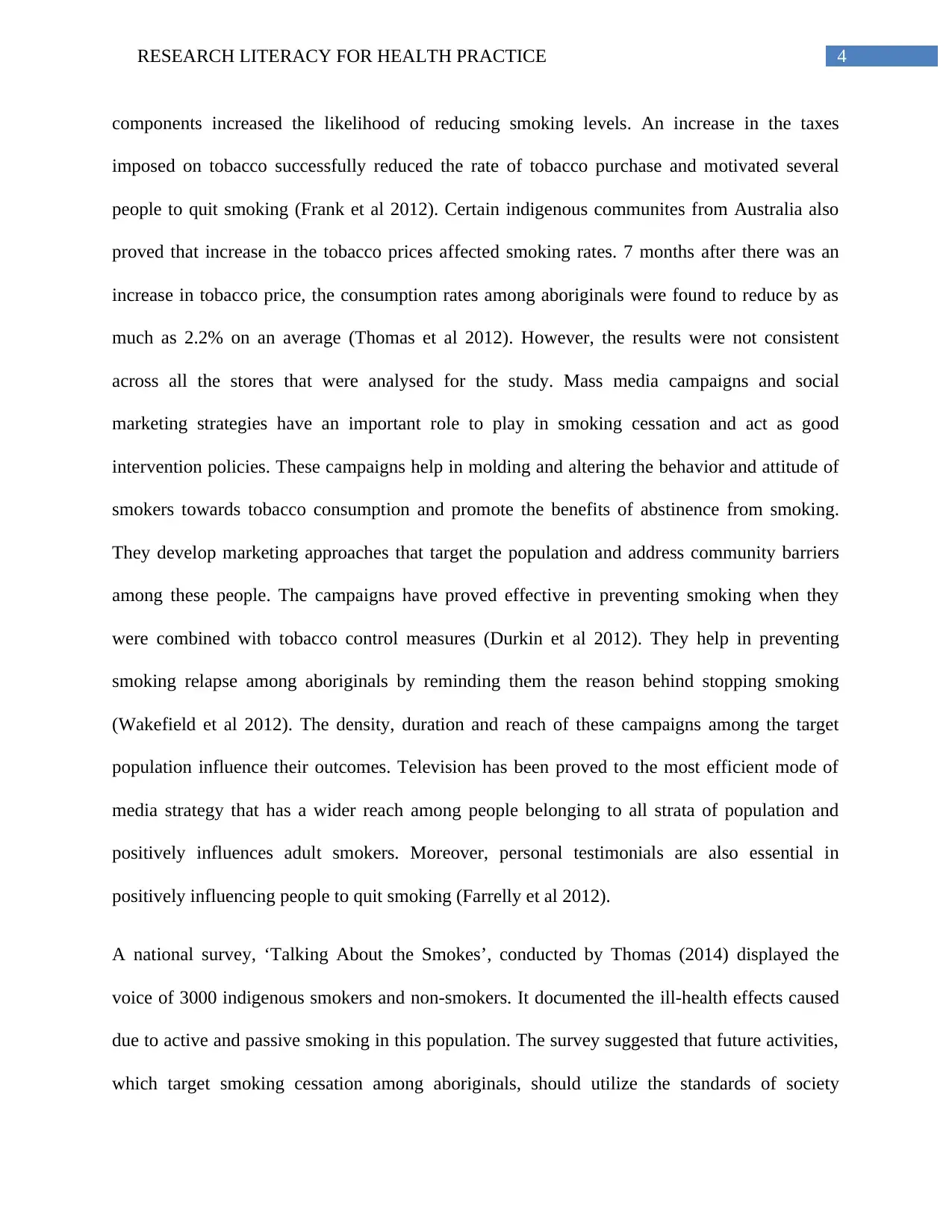
4RESEARCH LITERACY FOR HEALTH PRACTICE
components increased the likelihood of reducing smoking levels. An increase in the taxes
imposed on tobacco successfully reduced the rate of tobacco purchase and motivated several
people to quit smoking (Frank et al 2012). Certain indigenous communites from Australia also
proved that increase in the tobacco prices affected smoking rates. 7 months after there was an
increase in tobacco price, the consumption rates among aboriginals were found to reduce by as
much as 2.2% on an average (Thomas et al 2012). However, the results were not consistent
across all the stores that were analysed for the study. Mass media campaigns and social
marketing strategies have an important role to play in smoking cessation and act as good
intervention policies. These campaigns help in molding and altering the behavior and attitude of
smokers towards tobacco consumption and promote the benefits of abstinence from smoking.
They develop marketing approaches that target the population and address community barriers
among these people. The campaigns have proved effective in preventing smoking when they
were combined with tobacco control measures (Durkin et al 2012). They help in preventing
smoking relapse among aboriginals by reminding them the reason behind stopping smoking
(Wakefield et al 2012). The density, duration and reach of these campaigns among the target
population influence their outcomes. Television has been proved to the most efficient mode of
media strategy that has a wider reach among people belonging to all strata of population and
positively influences adult smokers. Moreover, personal testimonials are also essential in
positively influencing people to quit smoking (Farrelly et al 2012).
A national survey, ‘Talking About the Smokes’, conducted by Thomas (2014) displayed the
voice of 3000 indigenous smokers and non-smokers. It documented the ill-health effects caused
due to active and passive smoking in this population. The survey suggested that future activities,
which target smoking cessation among aboriginals, should utilize the standards of society
components increased the likelihood of reducing smoking levels. An increase in the taxes
imposed on tobacco successfully reduced the rate of tobacco purchase and motivated several
people to quit smoking (Frank et al 2012). Certain indigenous communites from Australia also
proved that increase in the tobacco prices affected smoking rates. 7 months after there was an
increase in tobacco price, the consumption rates among aboriginals were found to reduce by as
much as 2.2% on an average (Thomas et al 2012). However, the results were not consistent
across all the stores that were analysed for the study. Mass media campaigns and social
marketing strategies have an important role to play in smoking cessation and act as good
intervention policies. These campaigns help in molding and altering the behavior and attitude of
smokers towards tobacco consumption and promote the benefits of abstinence from smoking.
They develop marketing approaches that target the population and address community barriers
among these people. The campaigns have proved effective in preventing smoking when they
were combined with tobacco control measures (Durkin et al 2012). They help in preventing
smoking relapse among aboriginals by reminding them the reason behind stopping smoking
(Wakefield et al 2012). The density, duration and reach of these campaigns among the target
population influence their outcomes. Television has been proved to the most efficient mode of
media strategy that has a wider reach among people belonging to all strata of population and
positively influences adult smokers. Moreover, personal testimonials are also essential in
positively influencing people to quit smoking (Farrelly et al 2012).
A national survey, ‘Talking About the Smokes’, conducted by Thomas (2014) displayed the
voice of 3000 indigenous smokers and non-smokers. It documented the ill-health effects caused
due to active and passive smoking in this population. The survey suggested that future activities,
which target smoking cessation among aboriginals, should utilize the standards of society
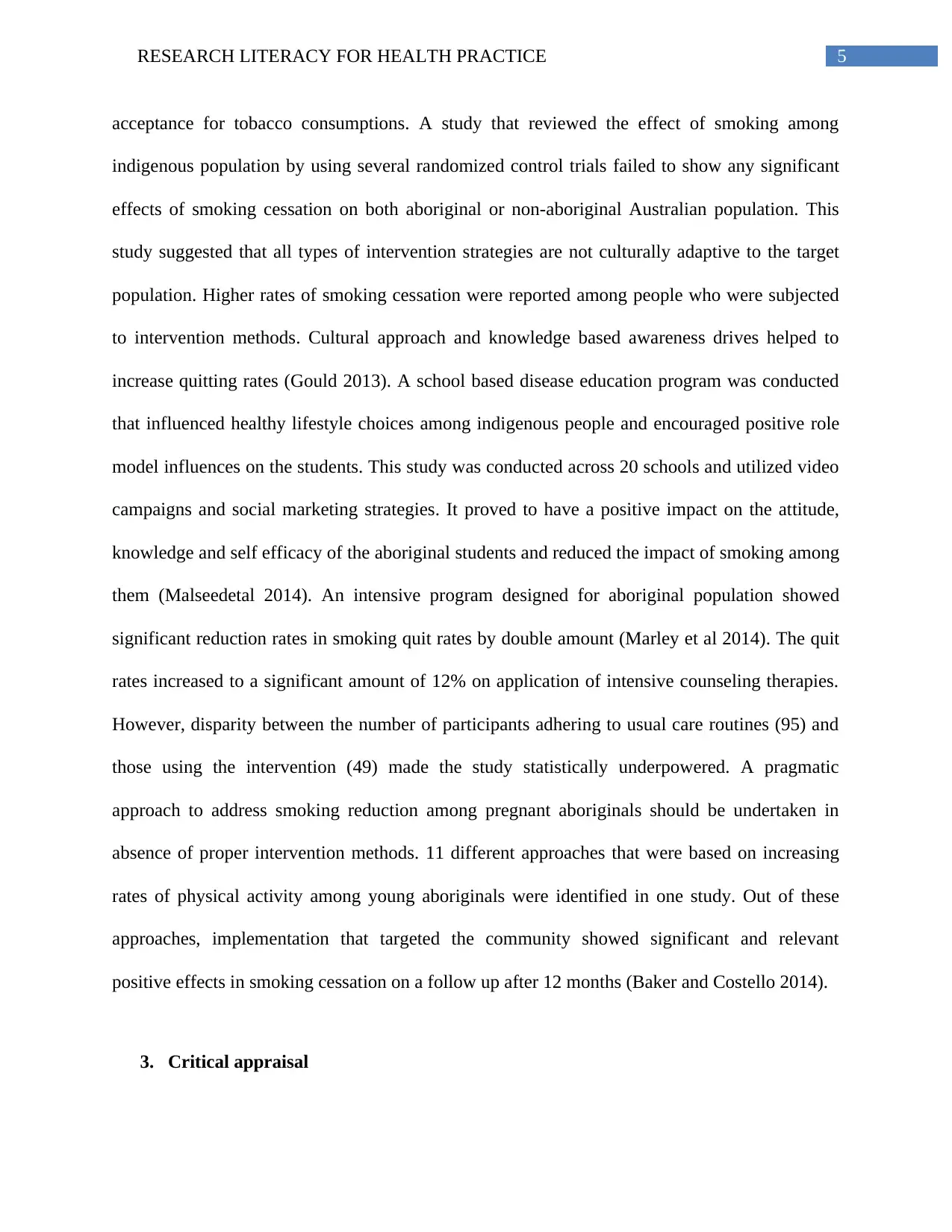
5RESEARCH LITERACY FOR HEALTH PRACTICE
acceptance for tobacco consumptions. A study that reviewed the effect of smoking among
indigenous population by using several randomized control trials failed to show any significant
effects of smoking cessation on both aboriginal or non-aboriginal Australian population. This
study suggested that all types of intervention strategies are not culturally adaptive to the target
population. Higher rates of smoking cessation were reported among people who were subjected
to intervention methods. Cultural approach and knowledge based awareness drives helped to
increase quitting rates (Gould 2013). A school based disease education program was conducted
that influenced healthy lifestyle choices among indigenous people and encouraged positive role
model influences on the students. This study was conducted across 20 schools and utilized video
campaigns and social marketing strategies. It proved to have a positive impact on the attitude,
knowledge and self efficacy of the aboriginal students and reduced the impact of smoking among
them (Malseedetal 2014). An intensive program designed for aboriginal population showed
significant reduction rates in smoking quit rates by double amount (Marley et al 2014). The quit
rates increased to a significant amount of 12% on application of intensive counseling therapies.
However, disparity between the number of participants adhering to usual care routines (95) and
those using the intervention (49) made the study statistically underpowered. A pragmatic
approach to address smoking reduction among pregnant aboriginals should be undertaken in
absence of proper intervention methods. 11 different approaches that were based on increasing
rates of physical activity among young aboriginals were identified in one study. Out of these
approaches, implementation that targeted the community showed significant and relevant
positive effects in smoking cessation on a follow up after 12 months (Baker and Costello 2014).
3. Critical appraisal
acceptance for tobacco consumptions. A study that reviewed the effect of smoking among
indigenous population by using several randomized control trials failed to show any significant
effects of smoking cessation on both aboriginal or non-aboriginal Australian population. This
study suggested that all types of intervention strategies are not culturally adaptive to the target
population. Higher rates of smoking cessation were reported among people who were subjected
to intervention methods. Cultural approach and knowledge based awareness drives helped to
increase quitting rates (Gould 2013). A school based disease education program was conducted
that influenced healthy lifestyle choices among indigenous people and encouraged positive role
model influences on the students. This study was conducted across 20 schools and utilized video
campaigns and social marketing strategies. It proved to have a positive impact on the attitude,
knowledge and self efficacy of the aboriginal students and reduced the impact of smoking among
them (Malseedetal 2014). An intensive program designed for aboriginal population showed
significant reduction rates in smoking quit rates by double amount (Marley et al 2014). The quit
rates increased to a significant amount of 12% on application of intensive counseling therapies.
However, disparity between the number of participants adhering to usual care routines (95) and
those using the intervention (49) made the study statistically underpowered. A pragmatic
approach to address smoking reduction among pregnant aboriginals should be undertaken in
absence of proper intervention methods. 11 different approaches that were based on increasing
rates of physical activity among young aboriginals were identified in one study. Out of these
approaches, implementation that targeted the community showed significant and relevant
positive effects in smoking cessation on a follow up after 12 months (Baker and Costello 2014).
3. Critical appraisal
⊘ This is a preview!⊘
Do you want full access?
Subscribe today to unlock all pages.

Trusted by 1+ million students worldwide
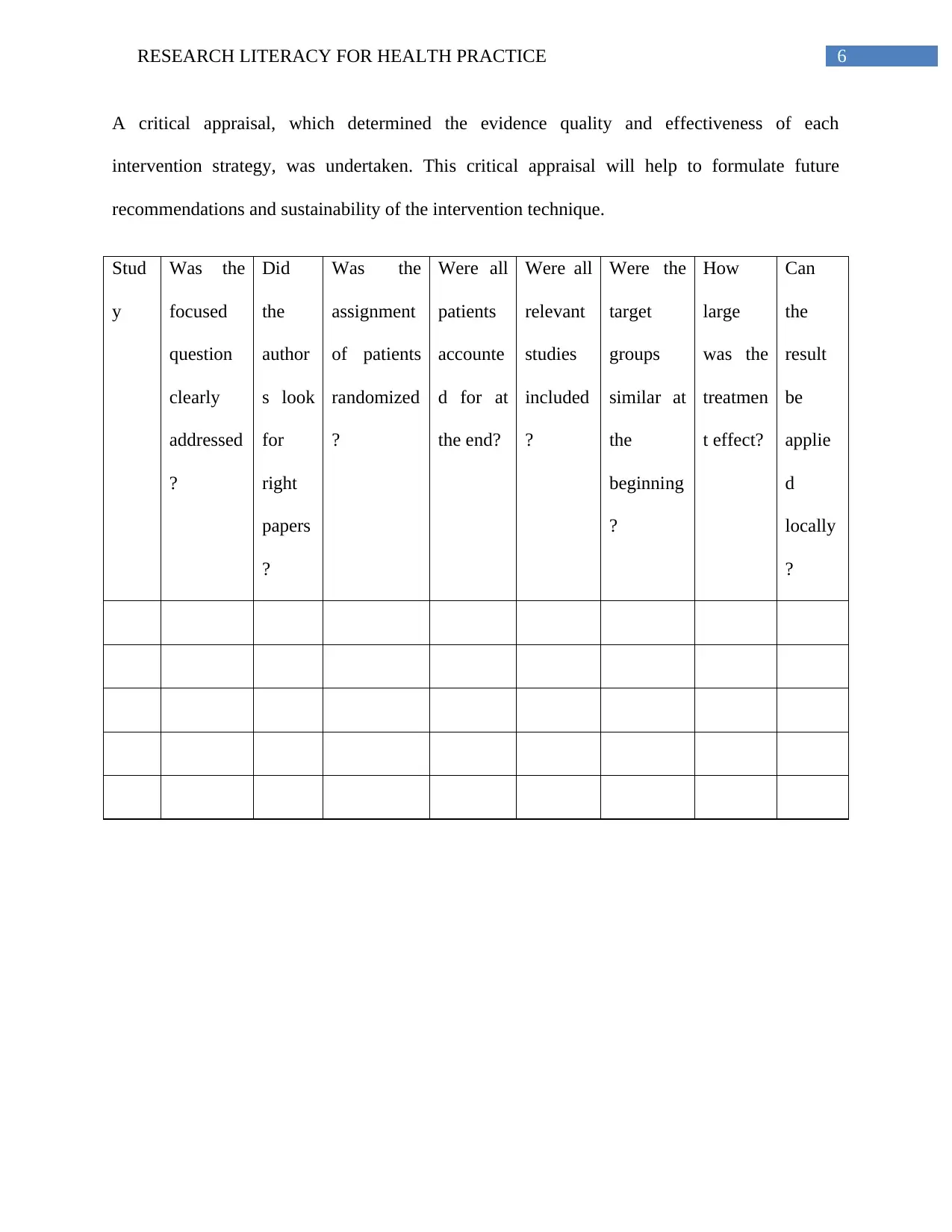
6RESEARCH LITERACY FOR HEALTH PRACTICE
A critical appraisal, which determined the evidence quality and effectiveness of each
intervention strategy, was undertaken. This critical appraisal will help to formulate future
recommendations and sustainability of the intervention technique.
Stud
y
Was the
focused
question
clearly
addressed
?
Did
the
author
s look
for
right
papers
?
Was the
assignment
of patients
randomized
?
Were all
patients
accounte
d for at
the end?
Were all
relevant
studies
included
?
Were the
target
groups
similar at
the
beginning
?
How
large
was the
treatmen
t effect?
Can
the
result
be
applie
d
locally
?
A critical appraisal, which determined the evidence quality and effectiveness of each
intervention strategy, was undertaken. This critical appraisal will help to formulate future
recommendations and sustainability of the intervention technique.
Stud
y
Was the
focused
question
clearly
addressed
?
Did
the
author
s look
for
right
papers
?
Was the
assignment
of patients
randomized
?
Were all
patients
accounte
d for at
the end?
Were all
relevant
studies
included
?
Were the
target
groups
similar at
the
beginning
?
How
large
was the
treatmen
t effect?
Can
the
result
be
applie
d
locally
?
1 out of 7
Related Documents
Your All-in-One AI-Powered Toolkit for Academic Success.
+13062052269
info@desklib.com
Available 24*7 on WhatsApp / Email
![[object Object]](/_next/static/media/star-bottom.7253800d.svg)
Unlock your academic potential
Copyright © 2020–2025 A2Z Services. All Rights Reserved. Developed and managed by ZUCOL.





